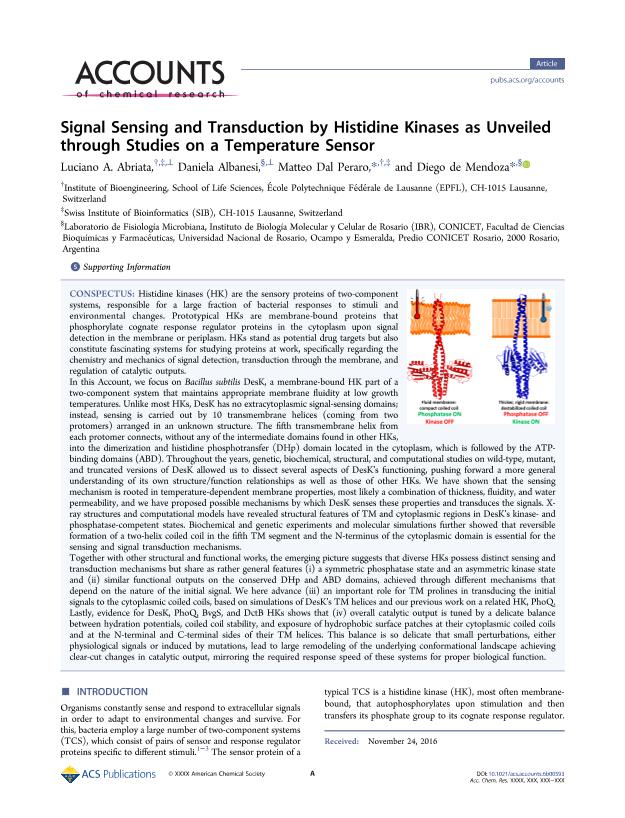Mostrar el registro sencillo del ítem
dc.contributor.author
Abriata, Luciano Andres

dc.contributor.author
Albanesi, Daniela

dc.contributor.author
Dal Peraro, Matteo
dc.contributor.author
de Mendoza, Diego

dc.date.available
2018-06-28T14:43:18Z
dc.date.issued
2017-06
dc.identifier.citation
Abriata, Luciano Andres; Albanesi, Daniela; Dal Peraro, Matteo; de Mendoza, Diego; Signal Sensing and Transduction by Histidine Kinases as Unveiled through Studies on a Temperature Sensor; American Chemical Society; Accounts of Chemical Research; 50; 6; 6-2017; 1359-1366
dc.identifier.issn
0001-4842
dc.identifier.uri
http://hdl.handle.net/11336/50337
dc.description.abstract
Histidine kinases (HK) are the sensory proteins of two-component systems, responsible for a large fraction of bacterial responses to stimuli and environmental changes. Prototypical HKs are membrane-bound proteins that phosphorylate cognate response regulator proteins in the cytoplasm upon signal detection in the membrane or periplasm. HKs stand as potential drug targets but also constitute fascinating systems for studying proteins at work, specifically regarding the chemistry and mechanics of signal detection, transduction through the membrane, and regulation of catalytic outputs. In this Account, we focus on Bacillus subtilis DesK, a membrane-bound HK part of a two-component system that maintains appropriate membrane fluidity at low growth temperatures. Unlike most HKs, DesK has no extracytoplasmic signal-sensing domains; instead, sensing is carried out by 10 transmembrane helices (coming from two protomers) arranged in an unknown structure. The fifth transmembrane helix from each protomer connects, without any of the intermediate domains found in other HKs, into the dimerization and histidine phosphotransfer (DHp) domain located in the cytoplasm, which is followed by the ATP-binding domains (ABD). Throughout the years, genetic, biochemical, structural, and computational studies on wild-type, mutant, and truncated versions of DesK allowed us to dissect several aspects of DesK’s functioning, pushing forward a more general understanding of its own structure/function relationships as well as those of other HKs. We have shown that the sensing mechanism is rooted in temperature-dependent membrane properties, most likely a combination of thickness, fluidity, and water permeability, and we have proposed possible mechanisms by which DesK senses these properties and transduces the signals. X-ray structures and computational models have revealed structural features of TM and cytoplasmic regions in DesK’s kinase- and phosphatase-competent states. Biochemical and genetic experiments and molecular simulations further showed that reversible formation of a two-helix coiled coil in the fifth TM segment and the N-terminus of the cytoplasmic domain is essential for the sensing and signal transduction mechanisms. Together with other structural and functional works, the emerging picture suggests that diverse HKs possess distinct sensing and transduction mechanisms but share as rather general features (i) a symmetric phosphatase state and an asymmetric kinase state and (ii) similar functional outputs on the conserved DHp and ABD domains, achieved through different mechanisms that depend on the nature of the initial signal. We here advance (iii) an important role for TM prolines in transducing the initial signals to the cytoplasmic coiled coils, based on simulations of DesK’s TM helices and our previous work on a related HK, PhoQ. Lastly, evidence for DesK, PhoQ, BvgS, and DctB HKs shows that (iv) overall catalytic output is tuned by a delicate balance between hydration potentials, coiled coil stability, and exposure of hydrophobic surface patches at their cytoplasmic coiled coils and at the N-terminal and C-terminal sides of their TM helices. This balance is so delicate that small perturbations, either physiological signals or induced by mutations, lead to large remodeling of the underlying conformational landscape achieving clear-cut changes in catalytic output, mirroring the required response speed of these systems for proper biological function.
dc.format
application/pdf
dc.language.iso
eng
dc.publisher
American Chemical Society

dc.rights
info:eu-repo/semantics/openAccess
dc.rights.uri
https://creativecommons.org/licenses/by-nc-sa/2.5/ar/
dc.subject
Histidine Kinase
dc.subject
Signal Sensing
dc.subject
Signal Transduction
dc.subject
Desk
dc.subject
Bacillus Subtilis
dc.subject.classification
Otras Ciencias Biológicas

dc.subject.classification
Ciencias Biológicas

dc.subject.classification
CIENCIAS NATURALES Y EXACTAS

dc.title
Signal Sensing and Transduction by Histidine Kinases as Unveiled through Studies on a Temperature Sensor
dc.type
info:eu-repo/semantics/article
dc.type
info:ar-repo/semantics/artículo
dc.type
info:eu-repo/semantics/publishedVersion
dc.date.updated
2018-06-28T14:04:25Z
dc.journal.volume
50
dc.journal.number
6
dc.journal.pagination
1359-1366
dc.journal.pais
Estados Unidos

dc.journal.ciudad
Maryland
dc.description.fil
Fil: Abriata, Luciano Andres. Consejo Nacional de Investigaciones Científicas y Técnicas; Argentina. Ecole Polytechnique Federale de Lausanne; Suiza. Swiss Institute of Bioinformatics; Suiza
dc.description.fil
Fil: Albanesi, Daniela. Consejo Nacional de Investigaciones Científicas y Técnicas. Centro Científico Tecnológico Conicet - Rosario. Instituto de Biología Molecular y Celular de Rosario. Universidad Nacional de Rosario. Facultad de Ciencias Bioquímicas y Farmacéuticas. Instituto de Biología Molecular y Celular de Rosario; Argentina
dc.description.fil
Fil: Dal Peraro, Matteo. Ecole Polytechnique Federale de Lausanne; Suiza. Swiss Institute of Bioinformatics; Suiza
dc.description.fil
Fil: de Mendoza, Diego. Consejo Nacional de Investigaciones Científicas y Técnicas. Centro Científico Tecnológico Conicet - Rosario. Instituto de Biología Molecular y Celular de Rosario. Universidad Nacional de Rosario. Facultad de Ciencias Bioquímicas y Farmacéuticas. Instituto de Biología Molecular y Celular de Rosario; Argentina
dc.journal.title
Accounts of Chemical Research

dc.relation.alternativeid
info:eu-repo/semantics/altIdentifier/url/http://pubs.acs.org/doi/abs/10.1021/acs.accounts.6b00593
dc.relation.alternativeid
info:eu-repo/semantics/altIdentifier/doi/http://dx.doi.org/10.1021/acs.accounts.6b00593
Archivos asociados
